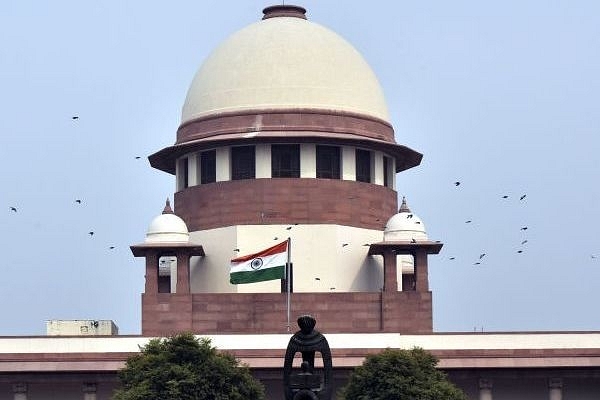
Who Is Responsible for India’s Supreme Court Teetering On the Edge?
To compare Indira Gandhi’s dictatorship to the elected government of Narendra Modi is grossly erroneous.
One can easily frame the NJAC judgement as a tyrannical, undemocratic Supreme Court striking down an amendment that was passed by a democratically elected Parliament and ratified by a majority of state legislatures.
Honestly, all that has been shaken to its core due to Modi is an “establishment” that has grown around a certain form of politics.
A lot of criticism has been directed towards the Supreme Court lately, especially with the latest sexual harassment allegations against the Chief Justice of India. Much of the criticism was based on the institutional and structural challenges that the court has been facing lately. The primary responsibility for the genesis of these issues lies within the court itself following its own conduct over the decades since the Emergency.
A recent article in The Atlantic however, seeks to blame the Narendra Modi government for the credibility crisis that the Supreme Court is facing.
Firstly, there is a factual error – in the first paragraph, the author, Atul Dev states that Emergency was declared after a High Court struck down an election result. This was not the case. Emergency was imposed a day after the Supreme Court upheld the order of the Allahabad High Court that had struck down former Prime Minister Indira Gandhi’s electoral victory from the Rae Bareli seat.
The author then proceeds to compare the Emergency period with the last five years of the Modi government, without any qualifiers, of course. The article, in fact, begins with the following sentence:
India has seen an autocratic ruler once before.
This is to strongly imply that the current dispensation is autocratic. To compare Indira Gandhi’s dictatorship to the elected government of Narendra Modi is grossly erroneous.
The author further states that Modi has centralized power from institutions that were supposed to keep a check on him. One wonders which institutions he is referring to, since the judicial tyranny of the Supreme Court has continued unabated. Next, the contention is that institutional autonomy of the educational, legislative, economic and investigative agencies has declined.
It is pointless to examine every single such unsubstantiated claim made by the author and debunk it thoroughly but it is imperative to mark out some points: it was this NDA Government that substantially increased the autonomy of the Indian Institutes of Management through a legislation in 2017, and is currently aiming to increase the autonomy of the Indian Institutes of Technology.
The greatest challenge to legislative autonomy meanwhile has, for a long while, been the Supreme Court, and not Narendra Modi, who currently enjoys the confidence of a majority in the Lok Sabha. To argue that Modi has weakened institutions is a good punchline, but it is clearly far from reality.
The article proceeds to talk about the National Judicial Appointments Commission (NJAC) judgement and the 99th Constitutional Amendment as examples of the “majoritarian” government being tamed by the Supreme Court. This is a great narrative but not a representative one: one can easily frame the NJAC judgement as a tyrannical, undemocratic Supreme Court striking down an amendment that was passed by a democratically elected Parliament and ratified by a majority of state legislatures.
The narration in the article then shifts to the allegations and incidents that have occurred in the Supreme Court in the past 3 years.
- The suicide note of the former Arunachal Pradesh Chief Minister, Kalikho Pul.
- Allegations of corruption against former CJI Dipak Misra.
- The Press Conference by four Senior Judges in January 2018.
- Sexual Harassment Allegations against the current CJI, Justice Ranjan Gogoi.
None of these are, in fact, the fault of the central government; they seem to be entirely self-made. But that does not stop the author from stating the following:
No inquiry has been opened into judicial corruption or independence, and the government has not been pressed on any links it has had to the courts.
This is by far the most accurate statement made in the entire article.
The government has failed to do anything about the allegations. But why is that? Because doing so would undoubtedly cause a constitutional crisis between the executive and the judiciary.
So far, the central government has been unwilling to risk such a thing. Besides, the greatest attempted reformation which had widespread support was the NJAC-Constitutional Amendment, and that was characterised as “impeding judicial independence” by the author. The author concludes in the following manner:
In the five years of Modi’s rule, almost every single Indian institution has been shaken to its core. The fissures are showing, most worryingly, in the judicial edifice. Even if Modi is voted out in these elections, the vulnerabilities he has exposed will remain for his successors to exploit.
Honestly, all that has been shaken to its core due to Modi is an “establishment” that has grown around a certain form of politics. The institutional cracks in the Judiciary have for long been apparent. They did not suddenly burst open in 2014 May when Modi came into power.
And yes, these fissures will be there after Modi is gone. He attempted to do the most broad-based reform of the judiciary since Independence but the court itself struck down the move. Can one then claim that Modi Sarkar has done nothing to solve the institutional problems of the Judiciary? No. It was the Supreme Court that refused to accept the reforms.
Surely, it is the Supreme Court that is responsible for the mess it finds itself in today.